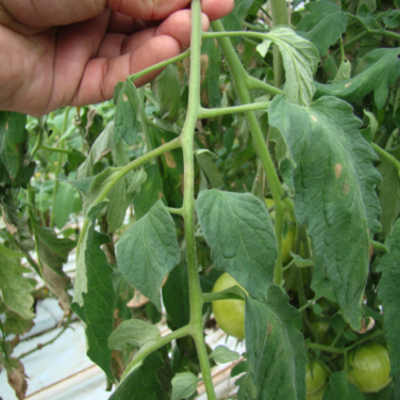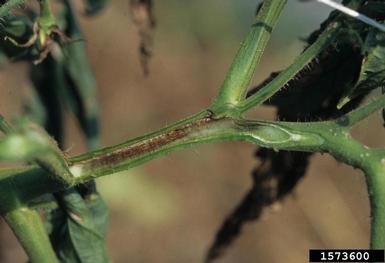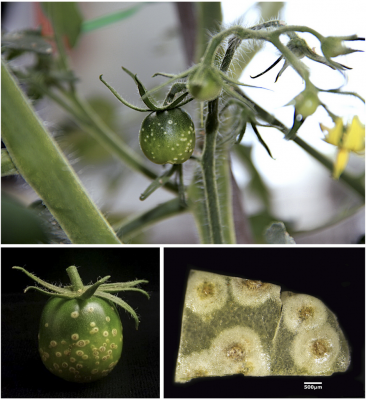Tomato Bacterial Canker
Author: Matthew DeBacco
Reviewed by: Shuresh Ghimire, Ph.D.
Associate Extension Educator
Extension Vegetable Specialist
Date of Publication: July 28, 2025
Introduction
Tomato bacterial canker is caused by the bacterium Clavibacter michiganensis subsp. michiganensis (Cmm). It is the most destructive disease of tomatoes in our region. The disease can substantially reduce yield, especially when it severely affects leaves early in the growing season, leading to wilted and stunted plants, delayed fruit maturity, cankers, and characteristic bird's eye spots on fruits. The impact on fruit quality is significant, causing disfigurement that reduces marketability, particularly for the fresh market. This can lead to significant yield losses, especially in greenhouses and high tunnel production.





Symptoms
Leaves: Initial small, dark spots may develop into larger areas of browning or scorching along the margins, often with a yellow halo. Leaves may wilt, curl upwards, and eventually die. There may be one side of the leaflet exhibiting wiltingwhich may be more commonly seen in greenhouses. Yellow to tan patches may form between veins, with brown edges and a yellow border, and veins can become dark and sunken, though this is not always visible.
Stems: Cankers or lesions may form with brown streaks in the vascular system, which are evident when cut open, and stem splits may form long, brown cankers. Yellow, sticky fluid may emerge when squeezed, indicating infection.
Fruits: Small (1/4” diameter), raised, dark brown lesions surrounded by a white halo, known as "bird's eye spots," andreducing marketability.
Host Crops: Solanaceae family (Tomatoes, Peppers, Eggplant)
Identification of Disease
Tomato bacterial canker affects tomato plants by inducing wilting, defoliation, desiccation, skin cankers, and reduced fruit yield and quality, ultimately leading to plant death. Research suggests that Cmm enters the tomato through natural openings, wounds (roots, stem, or fruits), or from infected seeds, multiplying in the cells responsible for water transport and producing a slimy biofilm that aids in colonization and movement. Symptoms can develop in approximately a week under favorable conditions, such as temperatures between 77°F - 86°F.
Not to be Confused with:
Bacterial Speck- Smaller spots and not systemic
Management
At this time there are no known tomato varieties with resistance to bacterial canker.
Cultural:
- Rotate out of tomatoes for at least 2 years
- Plant certified pathogen-free seed stock
- Do not save seeds from infected plants
- Hot water seed treatment (122F for 25min.)
- Disinfect stakes before reusing
- Avoid working in fields when plants are wet
- Clean pruning tools and any plant supports
Chemical:
- Use copper or streptomycin on plants before transplanting
- Chemicals by themselves are not sufficient to control the disease once it is established
- See New England Vegetable Managment Guide for a more comprehensive list of sray products
References
Cornell University. (n.d.). Bacterial canker. Cornell Vegetables. https://www.vegetables.cornell.edu/pest-management/disease-factsheets/bacterial-canker/
Egel, D. S. (2018, May 17). Tomato bacterial diseases: Bacterial canker. Vegetable Crops Hotline. https://vegcropshotline.org/article/tomato-bacterial-diseases-bacterial-canker/
Rubio, I., Motisi, N., Audeguin, L., Bertrand, M., Chastagner, A., Deberdt, P., Husson, O., Loiseau, M., Marie, L., Merlin, I., Meyer, J.-B., Pruvost, O., & Vallance, J. (2021). Bacterial canker of tomato: Current knowledge and future challenges. Plant Disease, 105(5), 1096–1113. https://doi.org/10.1094/PDIS-08-20-1732-FE
University of California Agriculture and Natural Resources. (n.d.). Bacterial canker. UC IPM Online. https://ipm.ucanr.edu/agriculture/tomato/bacterial-canker/
University of Florida, Institute of Food and Agricultural Sciences. (n.d.). Bacterial canker. U-Scout: Tomato. Retrieved July 2, 2025, from https://plantpath.ifas.ufl.edu/u-scout/tomato/bacterial-canker.html
University of Minnesota Extension. (n.d.). Bacterial canker of tomato. https://extension.umn.edu/disease-management/bacterial-canker-tomato
Consult and follow pesticide labels for registered uses. To avoid potential phytotoxicity problems, spot test before widespread use.
No discrimination is intended for any products not listed.
The information in this document is for educational purposes only. The recommendations contained are based on the best available knowledge at the time of publication. Any reference to commercial products, trade or brand names is for information only, and no endorsement or approval is intended. UConn Extension does not guarantee or warrant the standard of any product referenced or imply approval of the product to the exclusion of others which also may be available. The University of Connecticut, UConn Extension, College of Agriculture, Health and Natural Resources is an equal opportunity program provider and employer.